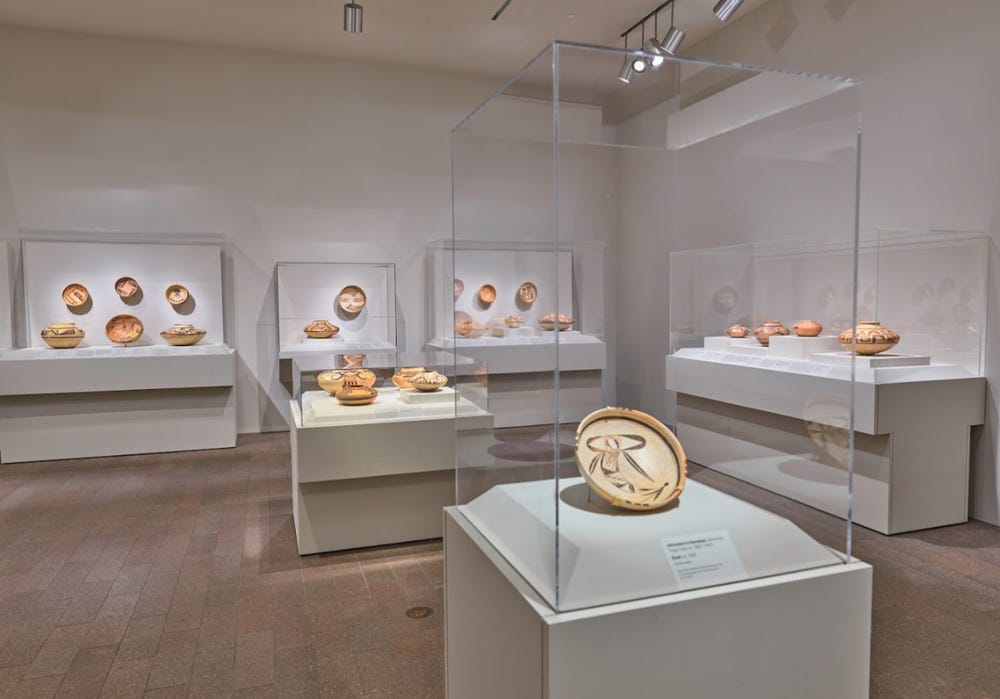Installation view of “Nampeyo and the Sikyátki Revival”.
de Young museum \ Through February 26, 2023
Celebrating the artistic ingenuity of Nampeyo, famed Tewa-Hopi potter, the de Young museum presents an installation of 32 pots from the collections of the Fine Arts Museums of San Francisco. The single-gallery exhibition highlights Nampeyo’s work, juxtaposed with examples of Hopi pottery from her time. Exquisite ceramics made by ancestral Hopi artists demonstrate Nampeyo’s sources of inspiration and artworks by four generations of her descendants attest to the master potter’s enduring legacy.
During her lifetime, Nampeyo (ca. 1860–1942) was, and remains today, perhaps the most renowned potter from the American Southwest. She is celebrated for her incredible skill as a potter and painter and also for her ingenuity as a designer. Born in Hano Village, a Tewa community on Hopi’s First Mesa in what is now Arizona, Nampeyo made pottery for her family and community but also sold works to the growing number of anthropologists, archaeologists, and tourists who visited Hopi. Soon, collectors across the country knew of Nampeyo and were eager to buy examples of her beautiful work.
Rather than following the contemporary Hopi style, Nampeyo drew inspiration from ceramic sherds found at abandoned ancestral villages near First Mesa, extrapolating the fragmentary designs. One village, Sikyátki, became the focus of an archaeological excavation, from which large, elaborately painted polychrome vessels were unearthed. Nampeyo studied these works, replicating the forms of the low, wide jars and adapting the colorful motifs made by ancestral Hopi artists in the fifteenth through seventeenth centuries. This distinct style, made famous by Nampeyo and often called Sikyátki Revival, became what outsiders most commonly associate with Hopi pottery. Nampeyo taught this art to her daughters, who in turn passed it on to their children. Today, Nampeyo’s descendents honor her legacy by perpetuating family designs and by adapting these motifs into their own unique aesthetics.
deyoungmuseum.org \ @deyoungmuseum
Exhibition Organization
The installation was co-organized by Bobby Silas and Hillary C. Olcott for the Fine Arts Museums of San Francisco. Silas is a Hopi potter who focuses on reviving the Sikyátki technique of making and firing ceramics. Olcott is associate curator of the arts of Africa, Oceania, and the Americas at the Fine Arts Museums of San Francisco.
This installation was made possible through generous support from the Weisel Family Art Foundation.
Visiting \ de Young
Nampeyo and the Sikyátki Revival is included in general admission to the de Young museum. As of November 29, 2020, the de Young Museum is temporarily closed per the state-issued COVID-19 mandate. For the latest information on reopening, please visit deyoungmuseum.org.
About the Fine Arts Museums of San Francisco
The Fine Arts Museums of San Francisco oversee the de Young, located in Golden Gate Park, and the Legion of Honor, in Lincoln Park. It is the largest public arts institution in San Francisco, and one of the most visited arts institutions in the United States.
The de Young originated from the 1894 California Midwinter International Exposition in Golden Gate Park and was established as the Memorial Museum in 1895. It was later renamed in honor of Michael H. de Young, who spearheaded its creation. The present copper-clad landmark building, designed by Herzog & de Meuron, opened in October 2005. Reflecting an active conversation among cultures, perspectives, and time periods, the collections on view include American painting, sculpture, and decorative arts from the 17th to the 21st centuries; arts of Africa, Oceania, and the Americas; costume and textile arts; and international modern and contemporary art.
